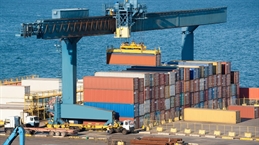
January's worldwide air cargo demand showed a significant increase compared to last year, according to Flexport, driven in part by Red Sea disruptions and the effects of the Lunar New Year.
In a statement, the full-service global freight forwarder and logistics platform noted that this rise in demand was seen across all main global regions except for ex-North America traffic.
"Due to disruptions in the Red Sea, some cargo owners are moving Asia-Europe cargo from sea to air or sea-air (e.g. air to ocean conversions)," Flexport said. "This shift, combined with the effects of the later Lunar New Year in 2024 (February 10) and typical mid-January seasonal trends, contribute to the increase in air cargo demand."
The report noted that despite major disruptions in international container shipping and a tripling of ocean freight spot rates from Asia to Europe, global air cargo rates remain relatively stable.
However, ex-Asia Pacific air cargo rates had already risen in late 2023 due to seasonal and product-related demand factors.
Forwarders are preparing for challenges in the next few weeks, including port delays and cargo build-up in Europe, as the booking window for air freight is closing ahead of the Lunar New Year.
"This situation may lead to increased reliance on air cargo," Flexport further said.
Meanwhile, comparing weeks 2 and 3 of 2024 with the same period last year, there's a 6% increase in overall global demand, with notable increases from the Middle East and South Asia, Africa, and Asia Pacific.
The report said average worldwide rates are 22% lower than last year but remain above pre-COVID levels. Air cargo capacity has also seen a significant year-over-year increase.
For ocean freight rates in the Indian Subcontinent to North America route, continue to increase into the first half of February as Red Sea disruptions show "no sign of mitigation."
Flexport said vessels that were delayed getting to their destination and then back to their origin due to diversions around the Cape of Good Hope have created capacity shortages.
"This short-term disruption is expected to be more challenging, while we expect some normalization in the longer term," the report added.
On the other hand, container deficits are carrier-specific, but recently there has been an increase in equipment issues being reported across many major wet ports and inland container depots.
Flexport also noted that several service updates, including MSC's removals of INDUSA (India-USEC) service, are resulting in a capacity crunch on their remaining INDUS EXPRESS service.
MSC has also removed the direct Karachi, Pakistan port call which had just been rolled out in late December.
"OOCL/COSCO removed AWES/ISE service (Mundra/BOS/NY/ORF) due to operational cost increases from Cape of Good Hope diversions. By removing this service, there is no longer a direct connection from India to Boston," Flexport added.
For Transatlantic Westbound, demand remains stable, with no peak expected to occur in February.
Flexport said carriers are still managing capacity based on the latest Red Sea developments. We expect capacity to be down by an average of 15-20%.
"Rates are expected to increase in February as several Red Sea-related surcharges go into effect on February 1. Indexes are expected to show the same in the next couple of weeks," the report added.
On-time performance decreased from 72% in July 2023 to 50% in December 2023 (based on Sea Intelligence data).
Flexport said this is quite normal during winter months as it is mainly caused by weather-related issues.
For Far East Westbound shipping, the Red Sea crisis continues to impact freight market development.
Vessels travelling back to Asia continue to face delays.
Moreover, carriers have started announcing a lack of equipment availability in ports ex-South China and some outports in Asia.
Flexport noted that demand also remains flat for the second half of February as the Lunar New Year approaches.
As a result, carriers are adjusting rates to cater to fresh cargo from the first half of February and to prepare for roll pool to fill vessels in the second half of February, despite massive void plans (weeks 8 and 9 are expected to see a 30% decrease on average).



